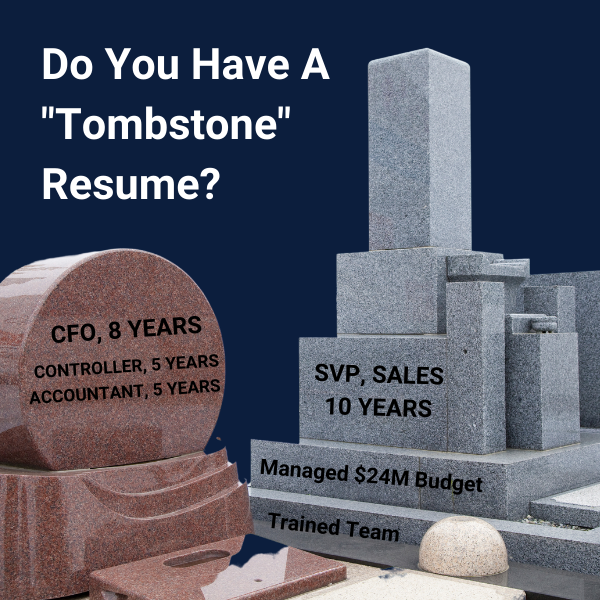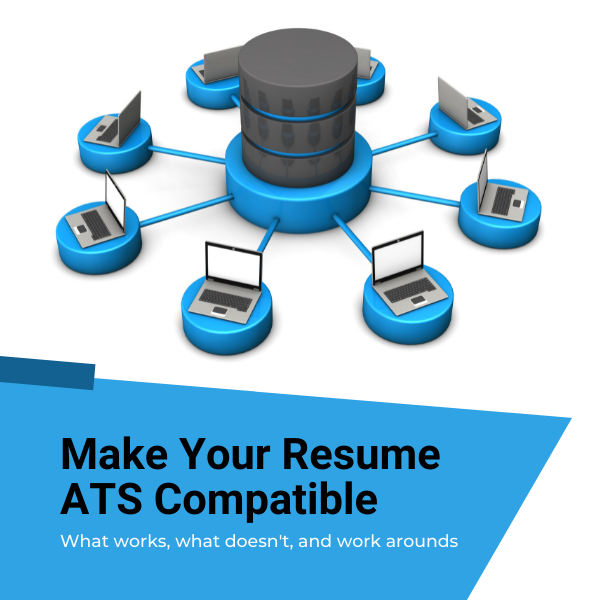Do You Have A “Tombstone” Resume?
While most people think of resumes as employment histories, today’s resumes are marketing tools designed to sell you (the product) to a potential employer (the buyer).
They are not boring lists of responsibilities. They are not a place to document everything you do on a day-to-day basis. They don’t include every job you’ve ever had or every single thing you’ve done during your career.
That style of resume is sometimes called a “Tombstone” resume because it focuses on the past, not the future.
To be effective, your resume needs to highlight the skills and achievements that make you valuable to potential employers.
What Future-Focused Means
The days of getting a job based on your experience or job title alone as long gone. You may think managing a $MM budget or having executives reporting to you is impressive. But, on it’s own, it’s not.
Resume Not Getting Results? Time To Turn Your Boring Employment History Into A Marketing Tool
Do you send your resume out just hoping for the best?
Do you share it with friends with the caveat that you just threw it together?
I’ve looked at thousands of resumes. Many potential clients I talk to today think their resume is “not too bad, probably needs a little tweaking.”
When I look at their resume from the perspective of a personal brand strategist and former recruiter, I see a resume that’s rubbish.
Long boring lists of duties and responsibilities, highlighted as achievements.
✔️ Developed and managed marketing campaigns for key clients . . .
✔️ Managed organizational functions for the largest global . . .
✔️ Worked closely with leadership on corporate communications . . .
Time to change that.
How To Create A Resume For An Internal Promotion
The only time most people think about their resume is when they’re looking for a new opportunity with a different employer. But, that’s not the case. A winning resume can increase your odds of success when applying for an internal promotion.
If you’re competing with outside candidates, you already have one thing going for you. You’re already there. When you have a history with the employer, they don’t have to worry whether or not you’re a culture fit.
Hopefully, you also know some, if not all, of the players which might include the hiring manager, the HR team, and anyone else with influence.
That said, you still need to sell yourself to get the job.
Words That Turn Hiring Managers Off (And Words They Love)
I can’t count the number of times I’ve seen someone describe themselves as a team player on their resume. I can say it’s way too many.
However, descriptors like team-player and out-of-the-box thinker make hiring managers cringe according to a 2021 CareerBuilder survey* of hiring managers and human resources pros.
How Recruiters Review Your Resume (It’s Not How You Think)
Just as resumes that don’t generate results have the same problems, resumes that resonate with recruiters and employers share commonalities. Effective resumes immediately grab the reader’s attention. They demonstrate what sets that candidate apart from the competition.
Many people think that recruiters begin by reading a resume from top to bottom.
However, the results of a 2012 Ladders study proved that in most cases, they don’t.
The Ladders had recruiters review resumes while wearing eye-scanning goggles. The main talking point, or buzz, from that study, was that recruiters spent less than 6 seconds reviewing each resume before deciding if they would interview the candidate or not.
How To Write Your Resume So It Won’t Get Lost In ATS Systems
All career professionals, particularly resume writers like me, say that you need to focus on your achievements. The best way to stand out from your competition is to demonstrate your value to employers. That’s true.
But even the most compelling resume won’t get you far if it’s not compatible with ATS (applicant tracking software system). Because important content, like your name and email address, may not be seen by recruiters and employers.
ATS Don’ts
While ATS systems are getting smarter all the time, and some are better at reading documents than others, your resume should be formatted to be read by most of them. Here are a few things to avoid.
Headers and Footers
Many ATS systems don’t read heads and footers, yet I still see resumes with the person’s name and contact information in the header. Headers are a suitable place to put your name and the page number. Footers on the second page are an excellent place to put your name and contact information if the printed pages are somehow separated.
Executive Resume Not Getting Results? This Is Probably Why
You may get away with updating the resume you’ve had since college or hastily putting together a resume on your own early in your career. However, once you reach the executive level or are targeting senior executive roles, you need a results-driven executive resume that tells a powerful career story.
The Career Ladder Myth
Most people think of climbing a career ladder. But the career ladder is a myth. It’s a career pyramid. Competition isn’t as tough for early careerists or even mid-level managers because there are a lot of jobs at those levels. As you move into Director, VP, SVP, and the C-Suite roles, however, there are not as many jobs.
How To Write An Executive Resume That Gets Results
Over the years I’ve looked at a lot of resumes. Some are dreadful. Those that are not as bad need work to get a recruiter’s attention. Particularly, once you reach the executive level.
Common Resume Mistakes
While the resumes are lacking in different ways, they all have some combination of the same problems.
Weak Content
Boring task-focused bullets (managed teams, developed new markets, etc.) or tons of metrics (reached 110% of quota, generated $8M revenue) with no story.
How To Give Your Boring Executive Resume Some Style
The first rule of executive resumes is that Content is KING! No matter how snazzy your resume looks, if your content doesn’t convey value it’s unlikely to generate job interviews.
That said, having a well formatted executive resume infused with color and style can help set you apart from your competition.
When it comes to formatting, the biggest problem with DIY resumes is sloppiness.
This is often seen in inconsistent bullets, employment dates that have migrated across the page, and teeny, tiny or weird fonts that no one can read.
How To Make Sure Your Resume Is ATS Friendly
Applicant tracking software systems or ATS systems electronically handle many recruitment and hiring needs. One applicant tracking system function is parsing each job application and resume looking for relevant keywords, skills, years of experience, former employers, job titles, colleges and universities, etc., based on employer criteria and store that information in a database.
To employers, who often get hundreds of applications for every position advertised on a job board, applicant tracking software is a boon. On the other hand, many job seekers refer to them as the “black hole.”
When I was working as a recruiter, at least 80% of the job seekers who responded to my job posting weren’t remotely qualified for the job. So before blaming the black hole, make sure you are a qualified candidate: your work experience matches most of the job opening’s requirements. Not necessarily all, but most.
It’s also essential to ensure that your resume is ATS-friendly.
Following are some of the most often asked questions about applicant tracking software systems. The answers won’t help you get contacted if you’re not a qualified candidate. They will help you create an ATS friendly resume.










